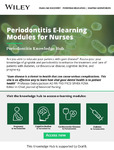Scoping review: Scope of practice of nurse‐led services and access to care for people experiencing homelessness
| dc.contributor.author | McWilliams, L | |
| dc.contributor.author | Paisi, Martha | |
| dc.contributor.author | Middleton, S | |
| dc.contributor.author | SHAWE, JILL | |
| dc.contributor.author | Thornton, A | |
| dc.contributor.author | Larkin, M | |
| dc.contributor.author | Taylor, J | |
| dc.contributor.author | Currie, J | |
| dc.date.accessioned | 2022-08-25T14:51:31Z | |
| dc.date.issued | 2022-07-27 | |
| dc.identifier.issn | 1365-2648 | |
| dc.identifier.issn | 1365-2648 | |
| dc.identifier.uri | http://hdl.handle.net/10026.1/19583 | |
| dc.description.abstract |
<jats:title>Abstract</jats:title><jats:sec><jats:title>Aims</jats:title><jats:p>To investigate the scope of practice of nurse‐led services for people experiencing homelessness, and the influence on access to healthcare.</jats:p></jats:sec><jats:sec><jats:title>Design</jats:title><jats:p>A scoping review.</jats:p></jats:sec><jats:sec><jats:title>Data Sources</jats:title><jats:p>On 20 November 2020, the following databases were searched: CINAHL, Embase, MEDLINE, PubMed and Scopus.</jats:p></jats:sec><jats:sec><jats:title>Review Methods</jats:title><jats:p>Included studies focused on people experiencing homelessness aged 18 years and over, nurse‐led services in any setting and described the nursing scope of practice. Studies were peer‐reviewed primary research, published in English from the year 2000. Three authors performed quality appraisals using the mixed methods assessment tool. Results were synthesized and discussed narratively and reported according to the PRISMA‐ScR 2020 Statement.</jats:p></jats:sec><jats:sec><jats:title>Results</jats:title><jats:p>Nineteen studies were included from the United States (<jats:italic>n</jats:italic> = 9), Australia (<jats:italic>n</jats:italic> = 4), United Kingdom (<jats:italic>n</jats:italic> = 4) and Canada (<jats:italic>n</jats:italic> = 2). The total participant sample size was <jats:italic>n</jats:italic> = 6303. Studies focused on registered nurses (<jats:italic>n</jats:italic> = 10), nurse practitioners (<jats:italic>n</jats:italic> = 5) or both (<jats:italic>n</jats:italic> = 4), in outpatient or community settings. The nursing scope of practice was broad and covered a range of skills, knowledge and attributes. Key skills identified include assessment and procedural skills, client support and health education. Key attributes were a trauma‐informed approach and building trust through communication. Important knowledge included understanding the impact of homelessness, knowledge of available services and the capacity to undertake holistic assessments. Findings suggest that nurse‐led care facilitated access to healthcare through building trust and supporting clients to access services.</jats:p></jats:sec><jats:sec><jats:title>Conclusion</jats:title><jats:p>Optimized nursing scope of practice can facilitate access to healthcare for people experiencing homelessness. Key factors in enabling this include autonomy in nursing practice, organizational support and education.</jats:p></jats:sec><jats:sec><jats:title>Impact</jats:title><jats:p>The broad range of skills, knowledge and attributes reported provide a foundation from which to design an educational framework to optimize the nursing scope of practice, thereby increasing access to healthcare for people experiencing homelessness.</jats:p></jats:sec> | |
| dc.format.extent | 3587-3606 | |
| dc.format.medium | Print-Electronic | |
| dc.language | en | |
| dc.language.iso | eng | |
| dc.publisher | Wiley | |
| dc.subject | access to healthcare | |
| dc.subject | health services accessibility | |
| dc.subject | homeless persons | |
| dc.subject | homelessness | |
| dc.subject | nurse-led | |
| dc.subject | nurses | |
| dc.subject | nursing service | |
| dc.subject | practice patterns | |
| dc.subject | nurses' | |
| dc.subject | scope of practice | |
| dc.subject | scoping review | |
| dc.title | Scoping review: Scope of practice of nurse‐led services and access to care for people experiencing homelessness | |
| dc.type | journal-article | |
| dc.type | Journal Article | |
| dc.type | Review | |
| dc.type | Systematic Review | |
| plymouth.author-url | https://www.webofscience.com/api/gateway?GWVersion=2&SrcApp=PARTNER_APP&SrcAuth=LinksAMR&KeyUT=WOS:000830475800001&DestLinkType=FullRecord&DestApp=ALL_WOS&UsrCustomerID=11bb513d99f797142bcfeffcc58ea008 | |
| plymouth.issue | 11 | |
| plymouth.volume | 78 | |
| plymouth.publication-status | Published | |
| plymouth.journal | Journal of Advanced Nursing | |
| dc.identifier.doi | 10.1111/jan.15387 | |
| plymouth.organisational-group | /Plymouth | |
| plymouth.organisational-group | /Plymouth/Faculty of Health | |
| plymouth.organisational-group | /Plymouth/Faculty of Health/School of Nursing and Midwifery | |
| plymouth.organisational-group | /Plymouth/REF 2021 Researchers by UoA | |
| plymouth.organisational-group | /Plymouth/REF 2021 Researchers by UoA/UoA03 Allied Health Professions, Dentistry, Nursing and Pharmacy | |
| plymouth.organisational-group | /Plymouth/Research Groups | |
| plymouth.organisational-group | /Plymouth/Research Groups/Institute of Health and Community | |
| plymouth.organisational-group | /Plymouth/Research Groups/Plymouth Institute of Health and Care Research (PIHR) | |
| plymouth.organisational-group | /Plymouth/Users by role | |
| plymouth.organisational-group | /Plymouth/Users by role/Academics | |
| dc.publisher.place | England | |
| dcterms.dateAccepted | 2022-06-20 | |
| dc.rights.embargodate | 2022-8-26 | |
| dc.identifier.eissn | 1365-2648 | |
| dc.rights.embargoperiod | Not known | |
| rioxxterms.versionofrecord | 10.1111/jan.15387 | |
| rioxxterms.licenseref.uri | http://www.rioxx.net/licenses/all-rights-reserved | |
| rioxxterms.licenseref.startdate | 2022-07-27 | |
| rioxxterms.type | Journal Article/Review |


